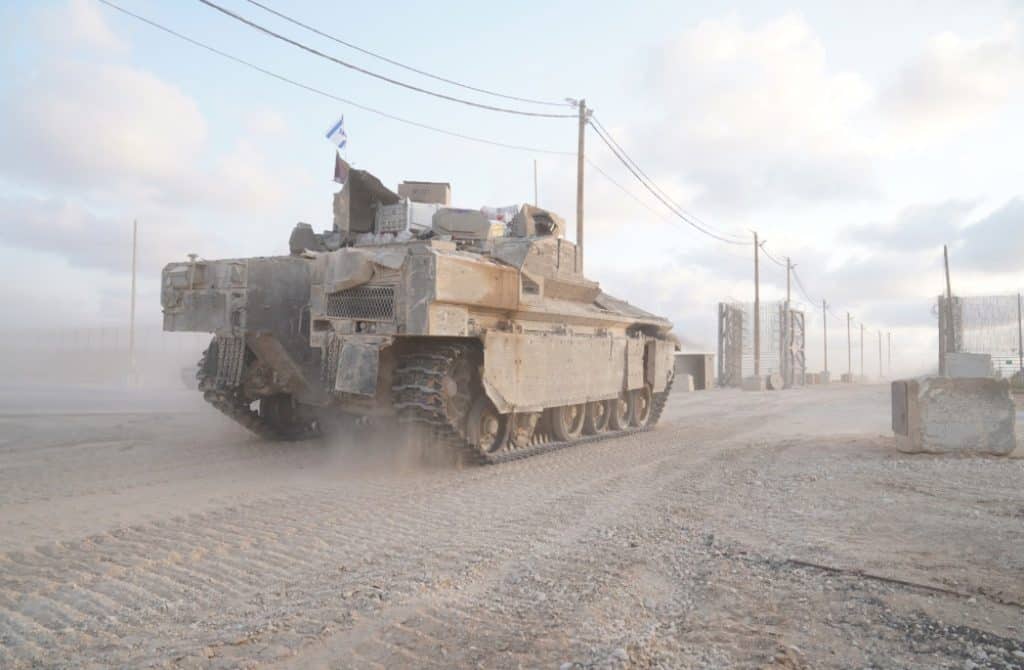
The Israel Defense Forces (IDF) expanded operations in northern Gaza overnight between October 5 and October 6, sending tanks and infantry into Jabliya, a suburb of Gaza City. It is the third time the IDF has operated in this neighborhood. The return of troops to northern Gaza comes as Hamas is seeking to rebuild its forces, and terrorist groups in Gaza launched rockets at southern Israel. The operation also started a day before Israel commemorates Hamas’s terrorist attack on October 7, 2023.
The IDF’s 162nd Division is leading operations in Jabliya. It had been deployed in Rafah between May and October, where it was responsible for eliminating more than 1,000 terrorists and securing the road along the Egyptian border called the Philadelphi Corridor.
The decision to send the 162nd Division into Jabliya was made as the IDF continued operating in Lebanon, which limits the regular army units it can deploy into Gaza. Israel currently uses reserve infantry and armored forces to secure the Netzarim Corridor south of Gaza City and other troops to secure the Philadelphi route in southern Gaza. The current operations in Gaza are vastly scaled-down compared to those during the first six months of the war.
Hamas has returned to Jabaliya, a repeated pattern in most of Gaza whenever Israeli forces withdraw. The IDF has preferred not to control dense urban areas for very long. Instead, troops go in and eliminate terrorists, tunnels, and related terror infrastructure before leaving and then often returning.
This is the third time the IDF has operated in Jabliya in a year. Israeli forces operated there in the opening campaign from November to January and again in May for several weeks. In May, the 98th Division cleared Jabliya. Now, the 98th fights in Lebanon while the 162nd conducts the current operations in the northern Gaza neighborhood. The 162nd includes the 401st Armored Brigade, which led the first offensive into northern Gaza on October 27 and has been fighting in the strip for a year.
Before the movement of infantry and tanks into Jabliya, the IDF conducted an airstrike on a Hamas command-and-control center in the suburb, the IDF said on October 5. “The command and control center, which was embedded inside a compound that previously served as a UNRWA center, was used by the Hamas terrorists to plan and execute terrorist attacks against IDF troops and the State of Israel.” At night, the soldiers moved in. The IDF said it had detected “efforts by Hamas to rebuild its operational capabilities in the area.”
As the IDF moved into Jabaliya, it also announced an expansion of the Mawasi Humanitarian Area on the coast of the Gaza Strip. This change may be in the expectation that many civilians will flee from northern Gaza towards the south. The IDF says it has created two humanitarian evacuation routes from Gaza’s north, one on Salah al-Din, the main road that leads from Gaza City to the south, and another on the Rashid coastal road.
On October 6, Hamas launched rockets towards areas near the Gaza border, indicating it continues to possess these threats in the short and perhaps medium ranges. “A projectile was intercepted, and the rest fell in open areas,” the IDF said.
During the first week of October, the IDF also carried out a number of airstrikes against Hamas members it accused of using schools to hide their activities. In one case, the Khalifa bin Zayed School in the northern Gaza Strip was struck. The IDF said it was a Hamas command-and-control center. Another of these sites was found in the Ibn Rushd School Deir al Balah and also hit, the IDF said. In a third instance, the IDF conducted an airstrike on the Ahmad al-Kurd School in central Gaza. In each case, the IDF says it takes measures to avoid civilian casualties.
The IDF, including Southern Command, is also preparing for October 7 anniversary memorial events in anticipation of the possibility Hamas or Palestinian Islamic Jihad may carry out attacks. “Ahead of the October 7th commemoration events, a detailed combat readiness plan was implemented. The IDF’s Gaza Division has been reinforced with several platoons, with forces stationed to defend both the communities and the border area,” the IDF said.
“This is a long war, measured not only by capabilities but also by the willpower and perseverance over time. For our enemies—every month, every week, and every day is worse than the one before. Even after the campaign ends, we will need to maintain our achievements, and our enemies will know, beyond any doubt, there will be no revival for those who seek to destroy us,” IDF Chief of Staff Lieutenant General Herzi Halevi said on October 6. “A year has passed, and we have defeated the military wing of Hamas, and we continue to fight against the organization’s terrorist capabilities,” he noted.
The IDF also released new footage from the October 7 attack related to fighting by the IDF’s Multidimensional Unit. Part of the 99th Division, this unit fought in Erez, Urim, Re’im, Be’eri, Alumim, and Nahal Oz.
Israel’s military also established a new exhibition of weapons and other gear that was found on terrorists after the attack. “The display includes vehicles and equipment used by the terrorists on October 7th to infiltrate into Israel, including pickup trucks, motorcycles, tractors, uniforms, intelligence documents, and the terrorists’ weapons including anti-tank missiles, RPG rockets, missiles, explosives, and UAVs of the Hamas terrorist organization.” The tally includes 70,000 items, including 1,250 anti-tank missiles and rocket-propelled grenades (RPGs).







